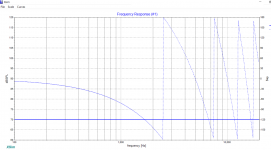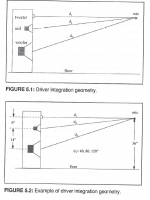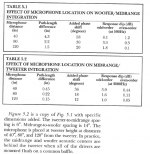Suppose I have a baffle with two tweeters. Please ignore diffraction or any reflections from the surroundings. One tweeter is mounted on top of the baffle. The other tweeter is mounted at 2.7 in. below the top tweeter. Also 2.7in. happens to be the wavelength of 5KHz sine wave tone.
Now if I place a microphone right at the tweeter on the top, then:
1. Play a 5KHz tone to both tweeter. Will the sound coming from the tweeter at the bottom be 360 degree delay vs. the top tweeter at the microphone?
2. Now if I play a 2.5KHz tone to both tweeter. Will the sound coming from the tweeter at the bottom be 180 degree delay vs. the top tweeter?
Wavelength calculator: Wavelength
Now if I place a microphone right at the tweeter on the top, then:
1. Play a 5KHz tone to both tweeter. Will the sound coming from the tweeter at the bottom be 360 degree delay vs. the top tweeter at the microphone?
2. Now if I play a 2.5KHz tone to both tweeter. Will the sound coming from the tweeter at the bottom be 180 degree delay vs. the top tweeter?
Wavelength calculator: Wavelength
Don't you trust the formula you have been using?
edit: this is a sim of a driver delayed by 2.7"
Thank you. To be honest, I can't be too sure.

I guess the reason I ask is to make sure I was at the same page with general accepted standard.
My real question is that some speakers are measured at say 1meter between the tweeter and mid driver. But there are speakers are measured at listening position such as 8ft length, 37in. height (or somewhere about there).
For example, if the measurement is done at 1 meter, the tweeter and the mid driver has a relative phase difference of some degree, say +70 degrees.
But as the microphone is moved further away say at 8ft which is about the listener position. Now the relative phase difference between the tweeter and the mid driver is less, say at 30 degrees (I guess in general, the phase difference between the drivers become less and less as it is measured at further distant, which means the the drivers are now better integrated).
On the one hand, it only matters at the listener position, but then most speakers are measured at 1 meter. In theory, should the xover be optimized at the listener position or at 1 meter as the usual standard? If the xover optimized at 1 meter, then response may not be optimal at the listener position and vice versa.
This may sound obvious to some but for some reasons I think there's more to it. Also, I've been trying to gather enough information to put together a paper on First Order / Time-Phase coherence design. As anything with time-phase coherence, everything seems more complicated than it usually is ... sigh ... the God.
My real question is that some speakers are measured at say 1meter between the tweeter and mid driver. But there are speakers are measured at listening position such as 8ft length, 37in. height (or somewhere about there).
For example, if the measurement is done at 1 meter, the tweeter and the mid driver has a relative phase difference of some degree, say +70 degrees.
But as the microphone is moved further away say at 8ft which is about the listener position. Now the relative phase difference between the tweeter and the mid driver is less, say at 30 degrees (I guess in general, the phase difference between the drivers become less and less as it is measured at further distant, which means the the drivers are now better integrated).
On the one hand, it only matters at the listener position, but then most speakers are measured at 1 meter. In theory, should the xover be optimized at the listener position or at 1 meter as the usual standard? If the xover optimized at 1 meter, then response may not be optimal at the listener position and vice versa.
This may sound obvious to some but for some reasons I think there's more to it. Also, I've been trying to gather enough information to put together a paper on First Order / Time-Phase coherence design. As anything with time-phase coherence, everything seems more complicated than it usually is ... sigh ... the God.
Also consider baffle effects/resonances. Too close doesn't work well, but too far is also a problem. Room surfaces appear closer, drivers are run at high level, mic input is lower so noise is higher.are now better integrated
Measuring at listening position is good for some testing, but not for designing.
Andy,My real question is that some speakers are measured at say 1meter between the tweeter and mid driver. But there are speakers are measured at listening position such as 8ft length, 37in. height (or somewhere about there).
In theory, should the xover be optimized at the listener position or at 1 meter as the usual standard? If the xover optimized at 1 meter, then response may not be optimal at the listener position and vice versa.
The distance from the tweeter and mid driver to the LP/mic position does not affect the phase response between the two, it's the angle between the two that determines the relative distance, and "time of flight" traveled between the two. The distance difference relates to the wavelength and phase.
The problem with the above, and crossover "optimization", is determining the "on axis" point. Assuming a tweeter located above the mid driver, if the center to center midpoint of the tweeter and mid driver is at 37" high, and the measurement distance is also 37", the distance traveled is equal between the two, and the relative phase between the two is unchanged by distance, 1 meter or 10 meters would measure the same in a free field (non-reflective environment). If the LP is moved higher, the distance traveled from the mid driver to the LP is longer than that traveled by the tweeter, and the wavelength of that distance difference determines the nulls and peaks for that angle and distance. Using the Pythagorean theorem you could determine what the distance (wavelength) difference is for any off-axis measurement and difference.
Last edited:
Fussing about phase from non-point-source sources will make you crazy. The cure is to test your speakers. Compare L, R, and same feed to both curves with a mic where your head would be.
Some frequencies, the same-feed/both will dip below the L or R (maybe both, not sure) indicating out of phase at your little ears at those freqs (or maybe if your ear was where the mic is placed but certainly different at the other ear). The wildness of the results will cure anybody of ever fretting about phase again.
Phase is a non-issue. Examining it like 7th grade geometry theorems may be satisfying but not real-world useful.
B.
Some frequencies, the same-feed/both will dip below the L or R (maybe both, not sure) indicating out of phase at your little ears at those freqs (or maybe if your ear was where the mic is placed but certainly different at the other ear). The wildness of the results will cure anybody of ever fretting about phase again.
Phase is a non-issue. Examining it like 7th grade geometry theorems may be satisfying but not real-world useful.
B.
On the one hand, it only matters at the listener position, but then most speakers are measured at 1 meter. In theory, should the xover be optimized at the listener position or at 1 meter as the usual standard? If the xover optimized at 1 meter, then response may not be optimal at the listener position and vice versa.
1 meter is common at home to eliminate reflections i.e. allow measurement of direct sound as low freq. as possible as a "far field measurement". It's not any official standard for producing measurement data for XO simulation. Sensitivity information NN dB/2.83V/1m in datasheets does not mean that the speaker or raw driver is actually measured at 1m. It's just unit allowing comparison.
Speaker and crossover is not - or at least should not be designed to single (listening) point either, though that could be the case if designer does not have, use or cope with proper methods and tools. Speaker should be designed and optimized to whole space it radiates and typical listening area - among few other features
Crossover simulator "scales" measurement data to all simulated virtual mic/ear locations, no matter where raw data is captured. "Scaling" is amplitude and phase/delay calculation and response interpolation from measurement data which does not usually contain responses exactly to all (or any!) off-axis directions which will be simulated. For example program called VituixCAD calculates each simulated off-axis response from four measured directions; two horizontal and two vertical (trying) to cover full space. Off-axis responses of drivers are captured in horizontal and vertical planes only, typically with 10 deg angle steps so exact directions and distances to any point in full space are not available for sure. Power response to full space could be result of max. 142 simulated frequency responses to different off-axis directions.
Frequency response scaling from short measurement distance to further listening/simulation distance is not perfect of course. Some errors exist if designer is forced to measure at short distance compared to dimensions of the radiator and simulated listening distance. We have to make some compromise between reflections and missing diffractions and possible near field effects if anechoic lab is not available.
Summary: Proper XO simulator takes care of all items you were worrying and asking. You can play freely with crossover and radiator locations, tilt and rotation if all radiators are measured around their center point and measurement data includes delay between mechanical rotation center and real acoustic center.
Thanks for all the responses so far. I am trying not to get too far away from my original question.
I post here two figures from D'Appolito book Testing Loudspeaker to more specifically illustrate the intent of my question.
One Figure is the picture of the microphone with respect to the 3way speaker at tweeter axis. The other Figure calculates the phase difference between the mid driver vs. the tweeter at mic position distant, and likewise, the woofer with respect to the tweeter.
Based on the Figures, the implication is that based on the distant from the speaker to the microphone, the relative phase difference between the various drivers will change.
The other implication is the further the mic, the relative phase difference is getting smaller and smaller as calculated on the chart. Can everyone agree on this?
Thanks.
I post here two figures from D'Appolito book Testing Loudspeaker to more specifically illustrate the intent of my question.
One Figure is the picture of the microphone with respect to the 3way speaker at tweeter axis. The other Figure calculates the phase difference between the mid driver vs. the tweeter at mic position distant, and likewise, the woofer with respect to the tweeter.
Based on the Figures, the implication is that based on the distant from the speaker to the microphone, the relative phase difference between the various drivers will change.
The other implication is the further the mic, the relative phase difference is getting smaller and smaller as calculated on the chart. Can everyone agree on this?
Thanks.
Attachments
Based on the Figures.....
We're back to 7th grade geometry.
Even if that diagram of point sources (which drivers are not) didn't excessively simplify the issue of phase, the fact that drivers "speak" at different speeds (and you don't know what speed...) needs to be remembered.
I'm not sure where the great 1970s fad for time alignment (AKA phase) stands today. On this forum, discussions of sub time-alignment seem to conclude that fine-tuning the alignment by ear and mic (which will keep you busy for a night) leads to a perceptible but rather small SQ benefit in the bass.
My gut feeling is that drivers should be within a cycle or two (360 to 720 degrees) in alignment for music to sound right. Gosh, that should irritate phase believers. I believe that based on decades of (a) sitting tweeter arrays on top of mids and not using a micrometer to position them and (b) having a big corner horn sometimes yards from the mids.
With a DSP you can fool with time-alignment (AKA phase) all you want and see if it matters.
B.
Last edited:
bentoronto,
Sorry but I lost it after the 7th grade comment thing. And your point?
My point: you can't over-simplify and "analyze" speakers as if they were Euclidian points as in the diagrams you posted.
As I specifically said, (1) drivers are not point sources in that their size is a bunch of degrees and (2) the drivers emit their sound at different latencies and polar angles.
I further provided specific comparisons that it makes no sense to talk about phase degrees because drivers and speakers are strewn about without regard to wave lengths and nobody knows or hears it and experiments with phase (AKA time alignment) do not seem too beneficial.
That is what I said in my previous post. Still having trouble getting my point?
B.
Last edited:
Still having trouble getting my point?
B.
Maybe.
I got the picture from D'Appolito Testing Speaker so I figure it has some merits because he's a speaker design and he might have some insights into speaker design. Now you say it's all wrong so I am kind of confused. Either he's wrong or you're wrong.
Yes. We may have different ways of doing it.Based on the Figures, the implication is that based on the distant from the speaker to the microphone, the relative phase difference between the various drivers will change.
The other implication is the further the mic, the relative phase difference is getting smaller and smaller as calculated on the chart. Can everyone agree on this?
Either he's wrong or you're wrong.
It's not black and white. Delay/phase calculation by distance works quite okay, but it's not accurate if shape of magnitude response changes when distance or especially off-axis angle changes, or acoustic center (at target frequency) of radiator travels while off-axis angle changes. Those depend on radiator's size and shape and wave length e.g. small radiator at low frequency is more reliable to estimate by distance only.
For example moving mic in D'Appolito's example causes magnitude and phase response changes to all drivers but mostly to woofer at HF. You could get decent result by distance, but not exact without measuring at each mic position.
As mentioned earlier, decent XO simulator is able to visualize these changes: calculate SPL change and phase summing including magnitude response and phase response and acoustic center changes if measurement data of drivers covers off-axis angle range including rotation of drivers and moving of microphone.
VituixCad is easy to begin with but has advanced features as well.
Blauert and Laws had that gut feeling too. I recall Earl telling you this a couple of months back.My gut feeling is that drivers should be within a cycle or two (360 to 720 degrees) in alignment for music to sound right.
It's not black and white.
I understand that but should we at least begin at some theoretical starting point even if the real world condition is a bit more complicated. The Figures I posted assumed that the xover at 500Hz and 3000Hz and the calculation was based on that assumption and the mic location. If we start to include multitude possible real world conditions, then it's hard to finish a design.
It's just simple illustration on how the phase can get affected by mic position. It does not pretend to be any more complicated than that.
Let's go back to the first message; one tweeter at the top and another in front, offset in Z=2.7". Rotating top tweeter 90 degrees could cause about 50 degrees phase change at 5 kHz due to (magnitude) response change, if we compare minimum phase responses. Sound source at target frequency could move few millimeters closer or further due to rotation so final phase change could be e.g. 35-55 degrees + phase change due to Z difference. Without introducing unnecessary drama, I wouldn't call phase calculation by distance "exact" if radiator is rotated that much  Simplifications and inaccurate approximations could be okay, but not mandatory with measurement data and decent XO simulator.
Simplifications and inaccurate approximations could be okay, but not mandatory with measurement data and decent XO simulator.
- Status
- This old topic is closed. If you want to reopen this topic, contact a moderator using the "Report Post" button.
- Home
- Loudspeakers
- Multi-Way
- Microphone position - theoretical phase shift delay



